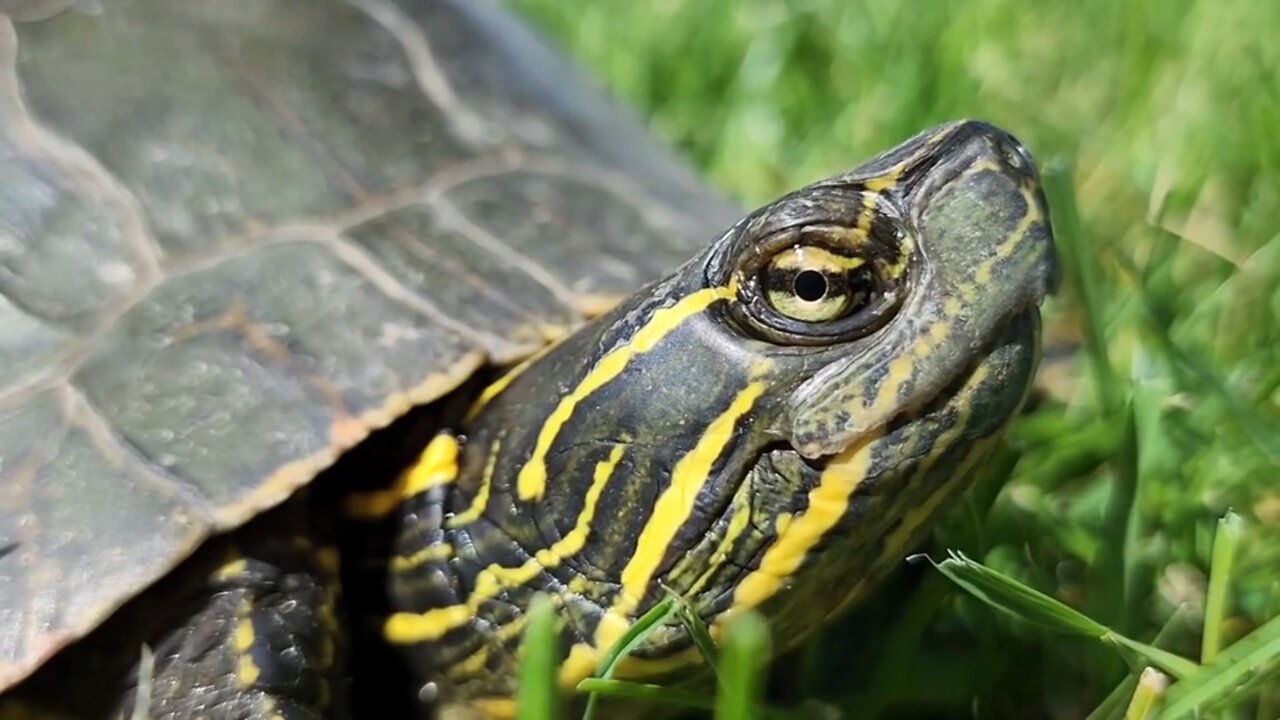Premium Only Content

"Timeless Turtles: Guardians of Land and Sea"
Turtles are fascinating reptiles belonging to the order Testudines, which also includes tortoises and terrapins. They are known for their distinctive shells, which serve as protection and distinguish them from other reptiles. Turtles are found in a wide range of habitats, from oceans and freshwater environments to land. Here's more about turtles:
### Physical Characteristics:
- **Shell:** The most distinctive feature of turtles is their shell, which is composed of two main parts: the upper part, known as the carapace, and the lower part, called the plastron. The shell is made of bone and is covered by scutes, which are plates made of keratin, the same material as human fingernails. The shell is an integral part of the turtle's skeleton and cannot be removed without harming the turtle.
- **Size and Appearance:** Turtles vary greatly in size and appearance. The smallest species, such as the speckled padloper tortoise, may be just a few inches long, while the largest, like the leatherback sea turtle, can grow to over 7 feet in length. Turtles typically have short, sturdy legs with claws or flippers, depending on whether they live on land or in water.
### Habitat and Distribution:
- **Aquatic Turtles:** Many turtles are aquatic or semi-aquatic, living in oceans, rivers, lakes, and ponds. Sea turtles, such as the green turtle and the loggerhead, are fully marine and travel vast distances across the oceans. Freshwater turtles, like the painted turtle or the red-eared slider, inhabit rivers, streams, and ponds.
- **Terrestrial Turtles:** Some turtles, like tortoises, are fully terrestrial and adapted to life on land. Tortoises, such as the Galápagos giant tortoise, are known for their slow movement and long lifespans.
- **Global Presence:** Turtles are found on every continent except Antarctica. They are highly adaptable and can live in a variety of environments, from tropical rainforests to arid deserts.
### Behavior and Diet:
- **Diet:** Turtles are generally omnivorous, though their diet can vary greatly depending on the species. Aquatic turtles often eat a diet of fish, aquatic plants, and invertebrates. Land turtles and tortoises tend to eat a mix of vegetation, fruits, and sometimes insects or carrion. Some species, like the green sea turtle, are primarily herbivorous, feeding on seagrass and algae.
- **Behavior:** Turtles are known for their slow movements, though some species can move quickly when necessary. Sea turtles, for example, are powerful swimmers capable of long migrations across oceans. Most turtles are solitary creatures, although they may gather in groups during basking or breeding.
### Reproduction:
- **Egg-Laying:** Turtles are oviparous, meaning they lay eggs. Female turtles typically dig nests in the sand or soil, where they lay a clutch of eggs. The number of eggs can vary widely depending on the species.
- **Temperature-Dependent Sex Determination:** In many species, the temperature of the nest determines the sex of the hatchlings. Warmer temperatures tend to produce females, while cooler temperatures produce males.
- **Hatchlings:** Turtle hatchlings are independent from birth and must find their way to water or safety immediately after hatching. This is a perilous journey, as many predators target the young turtles before they can reach safety.
### Conservation and Threats:
- **Endangered Species:** Many turtle species are endangered due to habitat destruction, pollution, climate change, and illegal hunting. Sea turtles, in particular, face significant threats from bycatch in fishing gear, plastic pollution, and loss of nesting beaches.
- **Conservation Efforts:** Various conservation efforts are in place to protect turtles, including protected nesting sites, captive breeding programs, and legislation to prevent illegal trade. Public awareness campaigns also aim to reduce human impact on turtle populations.
### Cultural Significance:
- **Mythology and Symbolism:** Turtles have been important symbols in various cultures throughout history. In some Native American traditions, the turtle is seen as a symbol of Mother Earth and longevity. In Hindu mythology, the world is believed to rest on the back of a giant turtle.
- **Turtles in Popular Culture:** Turtles have also been popular in modern culture, featuring in children's stories, cartoons, and as beloved pets.
### Longevity:
- **Long Lifespans:** Turtles are among the longest-living animals on the planet. Some species of tortoises can live for over 100 years. Even smaller turtles often live for several decades in the wild.
Turtles are remarkable creatures that have existed for over 200 million years, making them one of the oldest reptile groups alive today. Their unique adaptations have allowed them to survive in a wide range of environments, but they also face significant challenges in the modern world. Conservation efforts are crucial to ensuring that these ancient reptiles continue to thrive.
-
 18:38
18:38
VSiNLive
1 day agoProfessional Gambler Steve Fezzik LOVES this UNDERVALUED Point Spread!
28.3K5 -
 LIVE
LIVE
Right Side Broadcasting Network
9 days agoLIVE: President Donald J. Trump Keynotes TPUSA’s AmFest 2024 Conference - 12/22/24
23,119 watching -
 4:31
4:31
CoachTY
15 hours ago $10.62 earnedCOINBASE AND DESCI !!!!
45.2K6 -
 10:02
10:02
MichaelBisping
14 hours agoBISPING: "Was FURY ROBBED?!" | Oleksandr Usyk vs Tyson Fury 2 INSTANT REACTION
7.27K7 -
 8:08
8:08
Guns & Gadgets 2nd Amendment News
2 days ago16 States Join Forces To Sue Firearm Manufacturers Out of Business - 1st Target = GLOCK
59.5K60 -
 10:17
10:17
Dermatologist Dr. Dustin Portela
1 day ago $10.07 earnedOlay Cleansing Melts: Dermatologist's Honest Review
69.8K3 -
 1:02:20
1:02:20
Trumpet Daily
2 days ago $28.93 earnedObama’s Fake World Comes Crashing Down - Trumpet Daily | Dec. 20, 2024
45.1K40 -
 6:29
6:29
BIG NEM
23 hours agoCultivating God Mode: Ancient Taoist NoFap Practices
36.9K9 -
 30:53
30:53
Uncommon Sense In Current Times
1 day ago $8.86 earned"Pardon or Peril? How Biden’s Clemency Actions Could Backfire"
56.3K4 -
 40:01
40:01
CarlCrusher
21 hours agoSkinwalker Encounters in the Haunted Canyons of Magic Mesa - ep 4
52.4K2